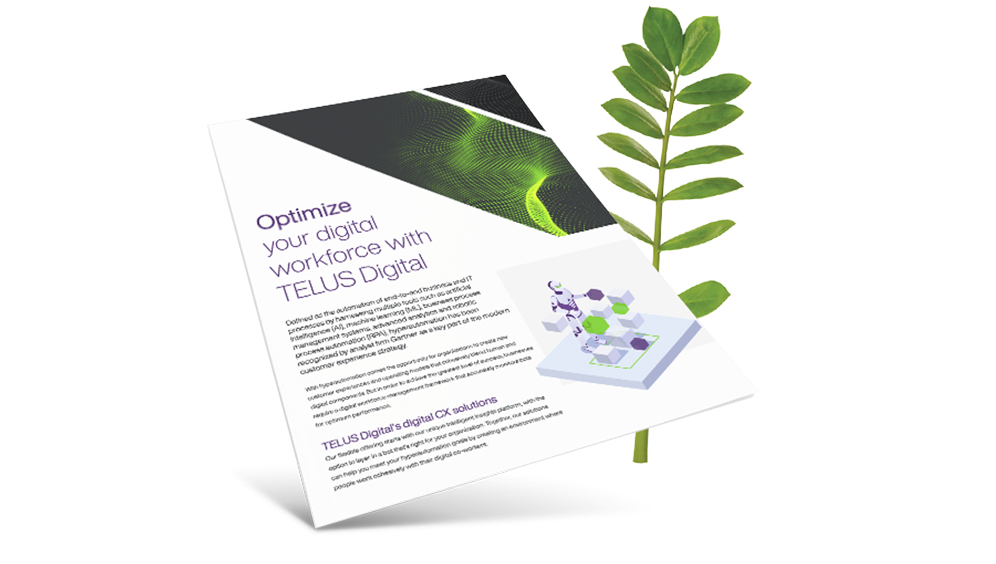
Increasingly powerful technology has helped supercharge the race to automate, and organizations are embracing back-office robotic process automation (RPA) and chatbots at unprecedented levels. According to Deloitte’s global survey of executives, 73% say their business has started its path towards intelligent automation, a leap from 58% in 2019. But the excitement surrounding digital transformation, combined with the growing popularity of remote workplaces, has highlighted some inefficiencies in the digital workforce.
Defined as a scalable team of bots that are used to augment the work of human employees, the digital workforce presents significant opportunities for brands across industries. Bots are known to improve customer experience, reduce customer effort, lower costs and increase efficiency. However, adoption is not without its challenges.
“Bot sprawl is a real pain point for organizations,” says Bryan Phillips, senior manager of product marketing at TELUS Digital. “That’s what early adopters are now realizing, especially with the acceleration of the pandemic and everybody moving to a remote workforce.” The transition has highlighted some of the challenges of managing digital co-workers, he says. It’s also shown that the key to capitalizing on the intelligently automated future is through optimization.
New opportunity, new challenges
Managing a digital workforce brings with it a learning curve. “For the traditional workforce management team, they’re used to a certain way of managing,” says Phillips. “The same parameters don’t apply to digital co-workers — for example, your bots don’t need lunch breaks, and they’re never stuck in traffic.” And while those examples may seem like small differences, the introduction of a digital workforce requires different types of resources to manage the digital team effectively.
Phillips says that’s why businesses looking to automate often encounter delays during rollout: “It’s so new, there just aren’t enough resources out there that have been able to manage bots properly or effectively in a short period of time.”
He says it often takes six to nine months to get digital co-workers optimized, compared to a human that can be fully trained and onboarded in a few weeks. That learning curve — or rather, the inclination to think of bots like human workers and apply a similar management methodology — is also a key contributor to bot sprawl. Ultimately, this can culminate in a drive to introduce new bots, when you could be using fewer instead and optimizing how you use them.
Another big challenge created by the race to automate is managing teams of bots from different vendors or on multiple licenses. You’re going to need subject matter experts for all of those different vendors, which translates into more costs for the organization. Phillips says more and more, discussions in the automation world are moving towards how to overcome these digital co-worker hurdles. In short, the novelty has worn off and now companies are looking to make the most of the technology at their disposal.
Now’s the time to optimize
The key to addressing these challenges is working with a tool that allows you to track your bot lifecycle and performance while analyzing return-on-investment and value creation by your digital workforce.
It needs to be vendor-agnostic, says Phillips, allowing for the management of a business’ bots regardless of vendor. It should also help you scale your automation efforts. He points to TELUS Digital’s proprietary digital workforce management platform Intelligent Insights, which allows automation ideas to be submitted and can take the RPA right from ideation to implementation.
Of course, part of optimization is using your bot licenses efficiently. He uses the example of a bot that runs a software update once a quarter but still needs a license to run it. “The other three and a half months that bot is not working,” he says. “Intelligent Insights can tell you when to use it, how to use it and how to build other RPA bots within that license so that you don’t have a license sitting idle for 80% of the year.”
Optimizing your digital workforce management with a centralized solution can also help bring more efficiency to the teams you need to manage the bots, give you visibility of your assets and reduce costs in the long run. “You’ll be more proactive as opposed to reactive when it comes to switching your bots in and out,” Bryan adds. “You’ll also be more well-balanced on the support and maintenance side of your bots.”
There’s a reason organizations have developed a big appetite for automation: bots can handle repetitive, mundane parts of the business, enabling human team members to focus on meaningful actions and high-touch support. A workforce that has both humans and bots will perform more efficiently. But the full benefits of a digital workforce can only be achieved through top optimization.



